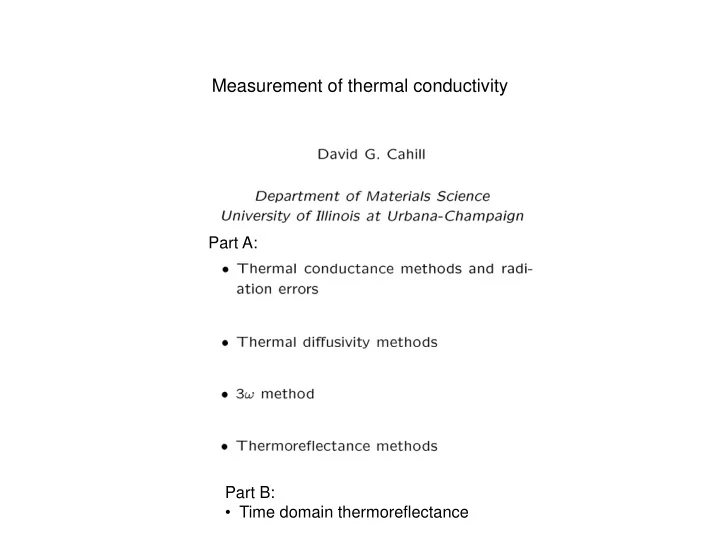

Measurement of thermal conductivity Part A: P Part B: t B • Time domain thermoreflectance
Λ = effusivity C
Modified Angstrom method takes into account thermal conductance from sidewalls to ambient Modern application to suspended polycrystalline Si microcantilevers (10 micron width) microcantilevers (10 micron width)
• At high temperatures, VT α 2 2 anharmonicity also increases the h i i l i h − = C C heat capacity κ P V – thermal expansion causes the vibrational modes to soften, f C α = κγ V increasing the vibrational V entropy per atom = C 3 Nk V B α = volume coefficient of thermal C expansion − = αγ P P 1 1 T T γ = Grüneisen constant 3 Nk κ = compressibility B Θ 1 dV V d α = γ = Θ D V dT dV D
Can get around this with a Can get around this with a multilayer where at least one layer is known
Typical calibration of Au film resistance vs. T
Solution for an infinite half-space P Δ = T r ( ) K ( qr ) l π l π Λ Λ 0 K 0 is the zeroth order modified Bessel function Think of this as the circular thermal wave Take the Fourier transform of this frequency domain solution
For a low thermal conductivity thin film For a low thermal conductivity thin film on a high thermal conductivity substrate (Factor of 2 because current is at frequency ω ) (Factor of 2 because current is at frequency ω )
Thermoreflectance Methods
Measurement of Thermal Conductivity Part B: Time-domain thermoreflectance David G. Cahill, Materials Research Lab and Department of Materials Science, U. of Illinois
Time-domain thermoreflectance
Time-domain thermoreflectance Clone built at Fraunhofer Institute for Physical Measurement, Jan. 7-8 2008
psec acoustics and time-domain thermoreflectance • Optical constants and reflectivity depend on strain and temperature • Strain echoes give acoustic properties or acoustic properties or film thickness • Thermoreflectance gives th thermal properties l ti
Schmidt et al., RSI 2008 • Heat supplied by modulated pump p p beam (fundamental Fourier component at frequency f) at frequency f) • • Evolution of surface Evolution of surface temperature time
Schmidt et al., RSI 2008 • Instantaneous temperatures measured by time-delayed probe • Probe signal as measured by rf lock-in measured by rf lock in amplifier
Analytical solution to 3D heat flow in an infinite half-space, Cahill, RSI (2004) • spherical thermal wave • Hankel transform of surface temperature • Multiply by transform of Gaussian heat source and take source and take inverse transform • Gaussian-weighted • Gaussian-weighted surface temperature 7
Iterative solution for layered geometries
Signal analysis for the rf lock-in • In-phase and out-of-phase signals by series of sum and difference over sidebands • • out-of-phase signal is dominated by the m = 0 term out of phase signal is dominated by the m = 0 term (frequency response at modulation frequency f )
Windows software author: Catalin Chiritescu author: Catalin Chiritescu, users.mrl.uiuc.edu/ cahill/ tcdata/ tdtr_m.zip
Thermoreflectance data for isotopically pure Si p • Two free fitting parameters – thermal conductivity, 165 W/ m-K – Al/ Si interface conductance, 185 MW/ m 2 -K Phoenix, Arizona 11
Time-domain Thermoreflectance (TDTR) data for TiN/ SiO 2 / Si TiN SiO 2 Si • reflectivity of a metal depends on temperature temperature • one free parameter: the “effective” thermal conductivity of the thermally grown SiO 2 layer 2 (interfaces not modeled separately)
TDTR: early validation experiments
Nothing really new...just faster and smaller
Thermal conductivity mapping • At t= 100 ps • At t= 100 ps, – in-phase signal is determined by the heat capacity of the Al film capacity of the Al film – out-of-phase signal is mostly determined by the effusivity ( Λ C) 1/ 2 of the substrate 15
Thermal barrier coatings • cross section of e-beam ZrO 2 : Y coating on (Ni,Pt)Al bond coat on Ni based bond-coat on Ni-based super-alloy (Rene N5)
ZrO 2 : Y thermal barrier • 500 thermal cycles 500 th l l between room temperature and engine p g operating temperature
ZrO 2 : Y thermal barrier, depth profile • penetration depth of thermal waves is 100 nm • angle polish and measure along a line to create a g depth profile • dull but important result: thermal conductivity is isotropic and homogeneous
Recommend
More recommend